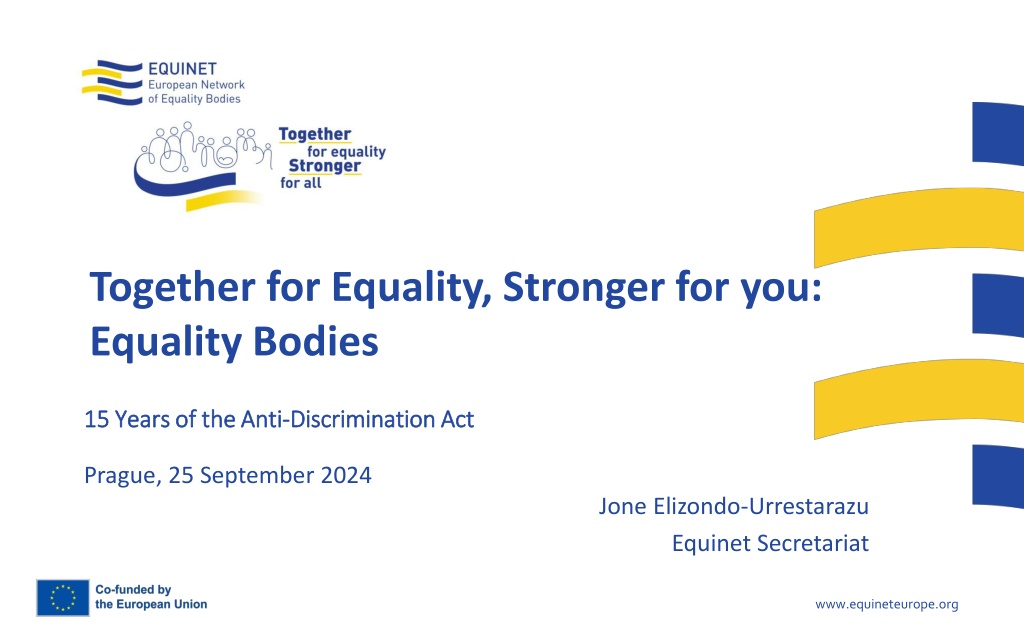
Promoting Equality: Role and Impact of Equality Bodies
"Learn about the key functions and importance of Equality Bodies in fighting discrimination, promoting justice, and empowering victims. Explore their potential in bringing social change, enforcing equality laws, and promoting good practices. Discover the evolution, standards, requirements, and ambitious implementation of Equality Bodies. Stay updated on recent directives, initiatives, and discussions shaping the future of equality rights."
Uploaded on | 0 Views
Download Presentation

Please find below an Image/Link to download the presentation.
The content on the website is provided AS IS for your information and personal use only. It may not be sold, licensed, or shared on other websites without obtaining consent from the author. If you encounter any issues during the download, it is possible that the publisher has removed the file from their server.
You are allowed to download the files provided on this website for personal or commercial use, subject to the condition that they are used lawfully. All files are the property of their respective owners.
The content on the website is provided AS IS for your information and personal use only. It may not be sold, licensed, or shared on other websites without obtaining consent from the author.
E N D
Presentation Transcript
Together for Equality, Stronger for you: Equality Bodies 15 Years of the Anti 15 Years of the Anti- -Discrimination Act Discrimination Act Prague, 25 September 2024 Jone Elizondo-Urrestarazu Equinet Secretariat www.equineteurope.org
Introduction to Equality Bodies and Their Role The Role of Equality Bodies in Promoting Justice and Empowering Victims Equality Bodies: Independent public organizations fighting discrimination. Key Functions: Monitor implementation of equality laws. Provide guidance, assist and support victims. Promote public awareness of equality issues. Importance: Serve as a bridge between law, policy, and societal needs, ensuring individuals' rights are protected and equality is promoted. 2
The Potential of Equality Bodies Social organisational individual change Effective monitoring and enforcement of equality law Horizontal approach covering many grounds and their intersections Countering under-reporting as low threshold expert bodies Developing national and European jurisprudence Promotion of good equality practices Awareness-raising Research and knowledge creation Monitoring statutory duties 3
The Quest for Standards 2016: Equinet Discussion Paper 2017: ECRI GPR No.2 2018: EC Recommendation 2021: EC Report on the application of the RED and the EED + Staff Working Document on Equality Bodies 2021-2022: Union of Equality strategies + public consultation 7 December 2022: Directive proposals 7 May 2024: Adoption - Directive 2024/1499 and 2024/1500 4
Requirements in the Directive Legally binding! Structures and Mandate: Clear mandates and independence. Adequate Resources: Financial, technical, and human resources. Prevention, promotion, awareness-raising Data collection Consultation Cooperation: Cooperation with other institutions and civil society to influence policy change. Assistance to victims: ADR, inquiries, decisions/opinions, litigation Accessibility and reasonable accommodation Monitoring 5
An ambitious implementation Legally binding! Clear rules and roles for monitoring Equinet contribution: Comprehensive Legal Analysis of the Directives (September 2024) Leadership on Equality Hub (September 2024) High-Level Round Table (October 2024) Toolkit for understanding and applying the Directives (October 2024) Exchange of good practices in Equinet s Standards Project 6
Monitoring implementation Legally binding! Not an accreditation process Common indicators to be developed by the EC on (with advice from EIGE, FRA, Equinet): resources, independent functioning, accessibility, effectiveness, developments in mandate, powers, structure What to take into account? Equinet indicators developed on mandate, independence, resources EC Working Group set up with MS representatives, EIGE, FRA, Equinet EU Directives themselves, ECRI GPR, academic inputs, consultations with Equality Bodies 7
Ensuring Access to Justice through Equality Bodies Reducing Barriers: Making legal systems more accessible to victims of discrimination. Simplifying complaint procedures. Providing legal assistance to victims. Mediation and Litigation: Alternative dispute resolution mechanisms can resolve issues faster. Role in Litigation: Bring cases before courts. Act as amicus curiae in support of victims. Ensuring Accountability: Holding perpetrators of discrimination legally accountable while working towards systemic reforms. 8
Empowering Victims: Tools and Strategies Education and Awareness: Providing knowledge on rights and legal recourses. Community outreach programs. Public campaigns to raise awareness about available protections. Victim Support Services: Free legal aid. Psychological and emotional support services information. Guidance throughout the legal process. Building Confidence: Empowering victims to speak up against discrimination through supportive structures that make the justice system approachable and effective. Ensuring Privacy and Safety: Confidential mechanisms to report and follow-up on cases without fear of retaliation. 9
THANK YOU FOR YOUR ATTENTION! ANY QUESTIONS ? EQUINET SECRETARIAT Place Victor Horta, 40, 1060 Brussels, Belgium info@equineteurope.org Tel: +32 (0)2 212 3182 info@equineteurope.org EquinetEurope www.equineteurope.org
